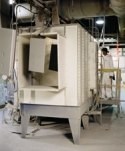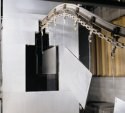New Pretreatment System Improves Corrosion Performance
The market for commercial icemaker worldwide approaches $400 million annually.
The market for commercial icemaker worldwide approaches $400 million annually. At the premium or "high end" of the market, there are many contenders. However, for most of this decade, the leadership position has been owned by one of four companies. Mile High Ice-O-Matic in Denver, Colorado, and three competitors (two U.S.-based and one in Asia) historically jockey for dominance in this market, which is estimated to be growing 2% per year.
Established in 1958, Mile High today is a division of Welbilt, a diversified group of hospitality equipment manufacturers owned by London-based Berisford Plc. Berisford's purchase in 1996 provided Mile High with excellent resources for growing export sales and an infusion of capital for advanced manufacturing technology. It also resulted in a competitive push toward quality in both the manufacturing process and final products. The first objective was ISO 9002 certification, a process that was already underway at the time of the acquisition.
In the manufacture of icemakers, corrosion is the number one issue. Top-of-the-market ice-making equipment is typically powder coated and the selection of cleaners, pretreatments and final rinses is critical, both for preventing rust and in maintaining good aesthetics. Since both are warranty issues, the stakes are high, whether the customer is a large restaurant chain such as Taco Bell or Europe's most popular tourist destination, EuroDisney.
The powder coating Mile High has used for more than a decade is a NSF epoxy. Pretreatment, in contrast, has undergone several evolutions. "Each time we made a change," said Dick Speck, water treatment technician and powder coating lead man, "the goal was performance, specifically, higher salt spray and better environmentals."
At the time Mr. Speck took responsibility for the finishing operations, the company operated a five-stage pretreatment system, which is the same equipment used today. The chemistry was based on a zinc phosphate system provided by a large, diversified chemical supplier. "It produced salt spray at 1,000 hours," said Mr. Speck. "That was excellent at the time. But there were disadvantages. It caused wastewater problems. The supplier had a three-drum minimum order. The technical support from the supplier was inadequate.
"The zinc phosphate was a difficulty, particularly for a company operating under the strict limitations of the Denver Metro Water district. My position prior to this was exclusively in wastewater treatment, so I am particularly sensitive to that issue. Our water treatment was like a roller coaster. It would be very alkaline and then suddenly very acidic or foaming. When I was promoted to lead man of the coating department, I disconnected the automatic pumps and did everything manually for a while. This gave us a true handle on what was occurring and why."
Then, for reasons that are still unclear, salt spray performance dropped to 500 hours. "Many of us were unhappy about this because we could not recover our 1,000 hours. When several other issues arose, we evaluated all of our information and did a complete assessment.
Mile High consulted Robert Westby, a Denver-based pretreatment specialist who suggested a system similar to the one used at Hobart Brothers, division of ITW in Troy, Ohio. The three chemistries at Hobart are a mild alkaline cleaner, a hybrid iron phosphate and a chrome-free final rinse. All three are manufactured by Challenge, Inc., Indianapolis, Indiana.
Mile High proceeded cautiously, installing first a spray cleaner, Challenge 1231, which operates a 3 to 4% concentration by volume, at 125F. "Notably," offered Mr. Speck, "the drum price of the chemical is slightly higher, but the active ingredients were significantly higher.
"The 1231 Spray Cleaner lowered chemical consumption dramatically. We were adding five to seven gallons of the previous cleaner at the time of the switch. 1231 allowed us to achieve a better result with two to three gpd, for the same production."
The next change at Mile High was the installation of Clean `N Coat 3011 in stage three. Clean `N Coat is a hybrid iron phosphate with a strong detergent package. It is operated at a concentration of 2 to 3% by volume at 120F. Clean N' Coat consistently develops 50 to 75 mg/sq ft of iron phosphate. "It, too, has a much higher level of active ingredients than what we were getting," said Mr. Speck.
The windowing problem Mile High had experienced had stemmed from its old stage three. "By running Clean `N Coat at the recommended concentration," said Mr. Speck, "the win-dowing went out the window." The net use of Clean `N Coat mirrored the company's experience with the cleaner. "We halved our use of phosphate and realized a net cost benefit of more than 30%.
Mile High's third change was in stage five, the heart of the pretreatment system. For this stage, Mr. Westby recommended a non-chrome, organometallic polymer synthesized by Challenge. Designated as Rinse 6107, the polymer is best described as bifunctional. One end of the polymer has an organic functionality that reacts with liquid or powder paint resins containing hydroxyl (OH), carboxyl (COOH) or amino (NH) functions. The other end of the polymer reacts with the metal pretreatment itself, yielding a reactive chemical bond between the metal and the coating.
Rinse 6107 creates a highly tenacious bond, and the combination of the chemical and physical properties that result is highly advantageous to users that require strong salt spray numbers coupled with excellent environmentals.
Concurrent with the installation of rinse 6107, Mile High added new deionized rinse equipment. "This served a dual purpose, said Mr. Speck, "because it keeps our TDS (total dissolved solids) low. In addition, it allows us to extend the time between bath changes. On May 1, I dumped a stage five and did not have to do it again until June 6. With our former system, we were dumping once or twice a week.
The pretreatment chemistry installed at Mile High today achieves 1,000 plus salt spray hours. "We have achieved 1,500 hours, tripling our original number," said Mr. Speck. "And we do it without zinc, chromium or heavy metals. We do it without anything that is classified as hazardous. This chemistry is the `greenest' alternative available."
Consistent 1,500 hour salt spray ratings would allow Mile High to consider extending its warranties, possibly to a level significantly beyond that of its competitors. It is one of Mr. Speck's primary objectives.
Within the pretreatment process, the company added a DI halo between stages four and five. "This improved the rinsing action prior to stage 5," he explained. "It also keeps the conductivity of the fifth stage even lower, thus lengthening bath life."
Mr. Speck also aspires to a time when the company is no longer required to be permitted as a metal finisher. "This is a tall order, but we believe that the new chemistry will make it possible," said Mr. Speck. "There are no limits on iron phosphate. You just have to do a pH adjustment and discharge." The benefit to Mile High will be a significant reduction in environmental compliance costs and paperwork.
"What all of this is about," added Mr. Speck, "is better performance. That is what I am after. Not golf games or baseball hats, performance and value. That is the real challenge after all."
Related Content
12 Ways to Improve Your Powder Coating Quality
Often overlooked powder coating procedures that can help you elevate your quality, streamline your operations and improve your profitability.
Read MoreLow-Temperature-Cure Powder Coatings Offer Unique Opportunities
An in-depth look at the advantages of low-temperature-cure powder coatings and the considerations for incorporating them into your process.
Read MoreAn Altruistic Growth Strategy Puts People First
Professional Plating emphasizes investing in its team and fostering a supportive environment on the shop floor.
Read MoreMasking Solutions Provider CFS Dramatically Expands Capabilities and Capacity
Custom Fabrication & Supplies (CFS) completed a new plant expansion packing 10 times the capacity into twice the space. It dramatically enhances the supplier’s custom capabilities to provide extremely precise and cost-effective masking solutions.
Read MoreRead Next
Education Bringing Cleaning to Machining
Debuting new speakers and cleaning technology content during this half-day workshop co-located with IMTS 2024.
Read MoreDelivering Increased Benefits to Greenhouse Films
Baystar's Borstar technology is helping customers deliver better, more reliable production methods to greenhouse agriculture.
Read MoreEpisode 45: An Interview with Chandler Mancuso, MacDermid Envio Solutions
Chandler Mancuso, technical director with MacDermid Envio discusses updating your wastewater treatment system and implementing materials recycling solutions to increase efficiencies, control costs and reduce environmental impact.
Read More
























